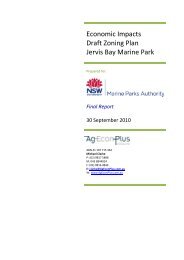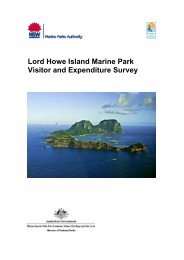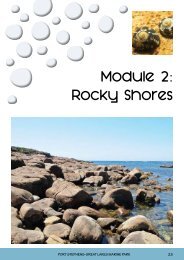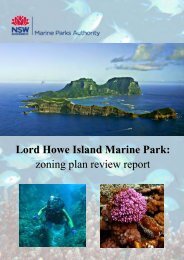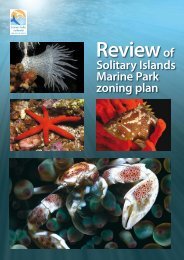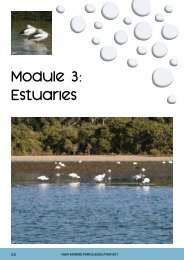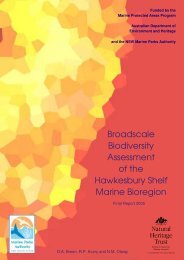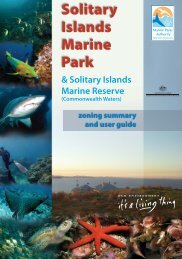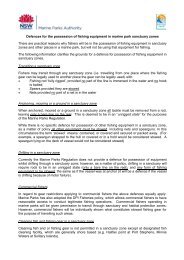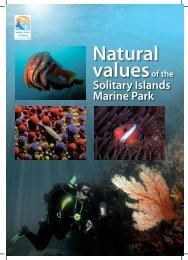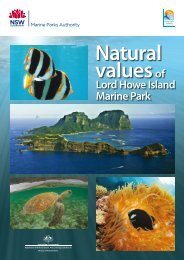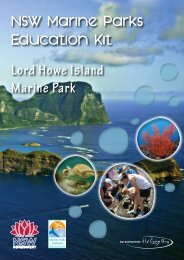Research Project Summaries 2002-2009 - Marine Parks Authority ...
Research Project Summaries 2002-2009 - Marine Parks Authority ...
Research Project Summaries 2002-2009 - Marine Parks Authority ...
Create successful ePaper yourself
Turn your PDF publications into a flip-book with our unique Google optimized e-Paper software.
elatively short lifecycle (three to four years), providing a quick response to protection.Methods of tagging were also assessed. Anchor t-tags inserted into the posteriormargin of the crab did not hinder movement or become detached during moulting.These tags were effective for long-term studies on movement patterns, and were usedthroughout the study. Crab behaviour around traps was assessed in special tanksusing video.The sampling program provided evidence that no-take zones were protectingmudcrabs, there were greater numbers of crabs of all sizes. Higher proportions ofmales were captured in the sanctuary zone sites, possibly due to:males being in higher abundance where traps were deployed, andfemales being more dispersed due to downstream travel as part of spawningbehaviour, andvideo analysis revealed that male crabs were initially dominant around baitedtraps and entered first However, all crabs of each gender soon entered, and didnot leave the trap.Sanctuary zone crabs spilt to adjacent fished areas. The extent of spill-over dependedto some degree on flooding, when low salinity pushed crabs downstream and outsideof sanctuary zones. However, between floods, crabs were primarily caught on theborder of sanctuary zones where recreational fishing pressure was the greatest.Abundances of legal-sized crabs declined within two months of opening areas thatwere previously closed to fishing in the Wooli and Corindi estuaries. Reopening of sitesalso distributed fishing away from the sanctuary zone borders, enabling crabs to movefurther into the fished area. Results suggested that closures are an immediate andeffective management tool for the recovery of overfished mudcrab stocks. At theprotected site, crab numbers and average size increased within months of closing, andthere was no change in the number of crabs caught each month in the area whererecreational trapping resumed.Telemetry studies in the Corindi River showed that the average daily distance moved,and the average distance moved from the release point, was greater in deep channelsthan in shallow Zostera-dominated channels. Therefore, there is a greater probability ofspill-over if sanctuary zones are located where deep channels form the border betweenfished and no-take areas. There is also a greater chance that shallow areas couldbecome locally depleted, being slower to recover after exploitation.The longer-term monitoring program continues from the studies that began in 1998(Butcher et al 2003, Butcher 2004) outlined above. A significant component of theearlier study assessed the influence of sanctuary zones implemented in <strong>2002</strong>. Themain objectives of the monitoring program are to:monitor and compare mudcrab densities in zones ‘open’ and ‘closed’ tocrabbing, before and after zoning changes in <strong>2002</strong>assess the influence of marine park zones by comparing the length, width andgender ratio of mudcrabs within and between different zonesmonitor the density and relative abundance of mudcrab populations in areasopen to fishing in the Solitary Islands <strong>Marine</strong> Park, as a locally importantfisheries resource.The three largest barrier estuaries have been monitored: the Wooli Wooli River sinceDecember 1998 and the Sandon and Corindi Rivers since 1999–2000. Each estuaryhas been sampled twice per year (April, December) for three nights. Three traps areSolitary Island and Jervis Bay <strong>Marine</strong> <strong>Parks</strong> <strong>Research</strong> <strong>Project</strong>s <strong>Summaries</strong> <strong>2002</strong>–<strong>2009</strong> 19



